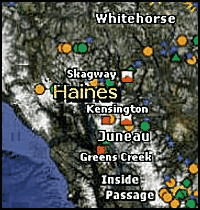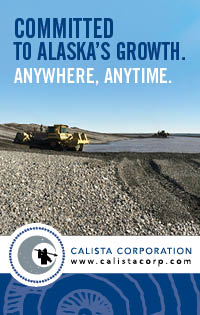Mining News: Minerals critical to restoring luster
 Click here to go to the full PDF version of this issue, with any maps, photos or other artwork that appears in
some of the articles. Click here to go to the full PDF version of this issue, with any maps, photos or other artwork that appears in
some of the articles.
Interest in strategic and critical minerals provides an opportunity for evangelists to expound the advantages of domestic mining
Shane Lasley Mining News
Mining, by definition, is an environmentally invasive practice of digging holes in the earth to extract the minerals found therein. This reality, coupled with a historical legacy of leaving unsightly scars that ooze metal-laden acidic waters, has given the modern mining industry a figurative black eye.
Champions of today’s extraction sector, however, see the strategic resources that are critical to national security, a strong economy and the development of a green energy future in the United States as an opportunity to restore luster to the tarnished image of those who dig up minerals for a living.
Why? These minerals are elemental to the standard of living humankind has become accustomed to in the 21st Century.
This message was a re-occurring theme at the 2012 Alaska Strategic and Critical Minerals Summit, a state government-organized gathering held in Fairbanks on Nov. 30.
“We are doing a good job of this in Alaska with events like this summit, but we really need to carry that message to other venues and to other industries beyond just mining. In particular, we need stronger coalitions with the manufacturers that rely on minerals for their products. We need to involve the processors, the marketers, the distributors and recyclers,” U.S. Sen. Lisa Murkowski, R-Alaska, told an audience at the gathering.
Dan McGroarty and Michael Silver, two other keynote speakers at the summit, agree that the mining industry must go beyond “preaching to the choir” and see the recent heightened interest in strategic and critical minerals as an opportunity to garner a larger awareness of the advantages of domestically mining materials important to national security, clean energy and high-tech innovation.
“We have some evangelists here,” McGroarty observed.
Seeking unobtainium Silver told participants in the summit that blockbuster movies such as “Avatar” further tarnish the public image of the mining industry and illustrate the disconnect between Hollywood’s perception of the mining industry and the reality of modern mining practices in the United States.
“We need to send people to Hollywood and say ‘you guys don’t get it,’” the chairman and CEO of California-based American Elements told the crowd.
In “Avatar,” an Earth-based mining firm, the Resources Development Administration, travels to the distant planet Pandora in 2154 to mine “unobtainium,” a mineral worth US$20 million per kilogram, due to its fantastic magnetic and superconductive properties. To acquire this fictional 22nd Century contemporary of today’s rare earth elements, the RDA is willing to displace Pandora Aboriginals, the Na’vi, and wreak havoc on the environment, including areas sacred to the Pandorans.
While “Avatar” is set on a far-away planet 150 years in the future, the plot of this film, written and directed by James Cameron, reflects the blemished façade of today’s earth-bound miners.
“It is a cultural problem and one that needs to be addressed,” Silver told the audience.
As opposed to Parker Selfridge, the RDA administrator willing to destroy the Na’vi civilization to mine the unobtainium and bolster the company bottom line in the movie, Silver would like to see real miners cast in roles more akin to Indiana Jones.
“What is more fun than going up into the mountains and discovering something and getting wealthy doing it,” the American Elements president reflected.
While only time will tell whether the two planned sequels to Avatar or other future Hollywood blockbusters will shine a more positive light on mining, the industry may be making some headway in the realm of video games.
In “Black Ops 2,” the latest installment of the popular “Call of Duty” series of video games, China has banned exports of rare earth elements, sparking a Cold War between the Middle Kingdom and the United States.
Said Mark Lamia, head of Treyarch, the studio that developed “Call of Duty: Black Ops 2: “It was very interesting to find out that the tension in the world, the wars that will be fought, will not be created by the tension over something like oil. Instead, it is more likely to be created by something that many people don’t know much about – something called rare earth elements.”
While the storyline is violent, a mainstay of the first-person shooter genre of video games, the more than 100 million people expected to play Black Ops 2 will be introduced to the once-obscure group of lanthanide elements.
Meanwhile, Silver, who would like to see miners cast as heroes on the silver screen, said his company is taking a more elementary approach to getting the word out.
American Elements – which sells more than 3,000 elemental metal, metallic-compound, ceramic and crystalline materials – is doing its part to enlighten young people about the basic building blocks of the universe by providing schools with magnetic periodic tables he said.
“They are really intended for kids to get excited about the periodic table; to recognize the alchemy of it; to recognize that the periodic table, Harry Potter and the alchemy of the Middle Ages are all one in the same,” Silver explained. “Magical things are happening every day in this world, and if they can make that connection, you are going to see more of the next generation moving into the industry that we are in.”
Critical mineral pioneers McGroarty, president of Washington, D.C.-based American Resource Policy Network, said Alaska is fortunate to have lawmakers on both the state and federal levels that understand the importance of a domestic supply of strategic and critical minerals.
“This state has committed to taking a strategic view of critical metals and that is really quite different than any other single state,” McGroarty said.
He urged the mineral savvy lawmakers and Alaska’s larger mining community to help his organization in its mission “to educate the public and policymakers on the need for natural resource development to reduce resource dependency that weakens U.S. economic competitiveness and national security.”
As part of this mission, ARPN is informing Washington D.C. policymakers that the United States:
•Has serious resource dependencies;
•Known resources that could alleviate or reverse those dependencies;
•A private sector ready to put capital at risk; and,
•A public policy regime that impedes action and dampens our competitiveness.
McGroarty delivered this message to the U.S. House of Representatives Subcommittee on Energy and Mineral Resources during a May oversight hearing on strategic and critical minerals policy.
He stressed in his testimony the importance of reducing America’s dependency on foreign countries to supply the minerals critical to green energy and the nation’s avant-garde defense systems.
He pointed to China’s monopoly on the global supply of rare earths and that country’s increasing restraints on exports of these technology minerals as a prime example of the dangers posed by this dependency.
“So, whether China withholds its rare earths supply for geo-strategic purposes, or consumes an ever-increasing amount of the metals it used to export to the so-called ― ‘Rest of the World’, the result will be the same – a shortage of a group of metals critical to our technological and economic development, as well as our national security,” McGroarty said.
While countries such as Australia, Japan and South Korea are moving rapidly towards securing reliable sources of rare earths and other critical minerals, McGroarty quipped that the United States is moving in “geological time.”
In contrast to the tectonic pace on the federal level, he praised Alaska’s progressive approach to critical minerals.
“Here you are in this state, and I know of no other, that puts together these strategic conferences; where you look at coordinating state agencies with all different stakeholders,” he said.
Despite the headway being made on the state level, Alaska must still contend with a cumbersome federal bureaucracy.
“How do you act or interact in Alaska as you put together strategic policy; and how do you do that where Washington, D.C. has some play?” McGroarty queried.
The answer may lie in Alaska’s pioneering spirit.
“Alaska is creating solutions to a problem that the policymakers on the federal level don’t even see,” McGroarty told Mining News during a Dec. 21 interview. “I think that is part of the challenge for Alaska, but if one takes this more evangelical view, maybe it is an opportunity.”
As a pioneering state in this realm, McGroarty believes Alaska has an opening to shape strategic and critical minerals policies.
“If states are the laboratory for reform then Alaska should move forward and not just create its own policy but (a policy that) would then stand for the other mining states as a possible direction for them to go,” he said. “It should not let the gridlock in Washington (D.C.) dissuade it from taking action.”
At the same time, the APRN president said Alaska policymakers should continue to be evangelists on the state and federal levels. In addition to spreading the word to their immediate peers, McGroarty suggested that the Alaska congressional delegation and state administration reach out to federal agencies such as the U.S. Department of Energy, Department of Defense and United States Geological Survey and even the White House.
“The White House has a critical metals working group; the Alaska delegation could seek to attach themselves as a state to that working group,” the ARPN president suggested.
By being actively involved on these various levels, Alaska can raise the awareness of the need for a domestic supply of strategic and critical minerals and the state’s potential to meet that need.
“Alaska will help itself if it helps the rest of the policymaking community understand the critical and strategic nature of domestic resource development,” McGroarty added.
Mining a green future Though McGroarty focused primarily on swaying perceptions in Washington, D.C., and Silver spoke on the need to gain influence in the nation’s opinion-shaping capital, both speakers see the current focus on the minerals critical to developing a green energy future as an opportunity for the mining and environmental communities to engage.
“Because technology is so critical to advancing the green energy alternatives, it is a moment for us to stop and think about the way that metals are necessary to make that transition – a moment to have a strange new respect for mining,” McGroarty observed.
He expects this respect to rise with the realization that the solar panels, wind turbines, electric cars and fuel cells envisioned to build a green energy future will require a large quantity and wide range of minerals.
“The only way we are going to build that future is by going into the ground and taking out the rare earths, taking out the lithium and taking out the materials we need to build that future,” said Silver.
This creates a Catch-22 for the environmental community, he said.
“They have to reconcile the supply chain,” Silver said. “The environmental movement can’t have it both ways.”
McGroarty and Silver both said that if the massive amounts of minerals needed to build the green energy infrastructure and products are not mined in the United States or some other developed country with stringent environmental policies, they will be sourced from places with fewer regulations, such as the Congo or China.
While environmentalists may find it impossible to see the world from a miner’s perspective, and vice versa, Silver said the oftentimes opposed groups may find common ground in responsibly sourcing the materials needed to build a green energy future.
Beyond the environmental implications, a domestic source of the elements needed to build this green energy future in the United States could bolster the economy along the entire supply-chain.
“Somebody, somewhere is going to mine those things, and they are going to build the solar panels, and we will just buy them. McGroarty told Mining News. “Let’s mine these materials and build them out of the stuff they are made of.”
“I think that governments need to sit down with all of the stakeholders and make people realize that the green technology future that we all want requires mining; that is where the supply-chain begins,” Silver said.
Mining has at least one evangelist on Capitol Hill that agrees.
“We need every step in the supply-chain to understand the benefits of producing these minerals in a place like Alaska,” Murkowski told the summit.
| 
 Click here to go to the full PDF version of this issue, with any maps, photos or other artwork that appears in
some of the articles.
Click here to go to the full PDF version of this issue, with any maps, photos or other artwork that appears in
some of the articles.







